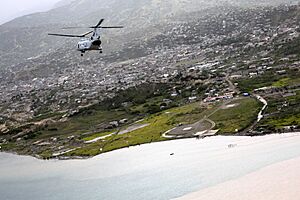Port-de-Paix facts for kids
Quick facts for kids
Port-de-Paix
Pòdepè / Pòdpè
|
|
|---|---|
|
Commune
|
|

Aerial view
|
|
| Country | Haiti |
| Department | Nord-Ouest |
| Arrondissement | Port-de-Paix |
| Population
(2015)
|
|
| • Commune | 462,000 |
| • Metro | 306,217 |
| Time zone | UTC-5 (Eastern) |
| • Summer (DST) | UTC-4 (Eastern) |
Port-de-Paix (which means "Port of Peace") is an important city in Haiti. It is the capital of the Nord-Ouest department. This city is located on Haiti's Atlantic coast. In 2015, about 462,000 people lived there. Long ago, Port-de-Paix was known for exporting bananas and coffee.
Contents
Geography of Port-de-Paix
Port-de-Paix is built on a small flat area near the Atlantic Ocean. It is close to the Tortuga Canal and the Three-Rivers area. The land around the city is mostly used for farming.
The city is divided into several parts called communes:
- I. The main city area of Port-de-Paix
- II. Baudin
- III. Aubert
- IV. Mahotière
- V. Bas-des-Moustiques
- VI. La Corne
Port-de-Paix is also the main town of an arrondissement (a type of district) with the same name. This district includes five communes: Port-de-Paix, La Pointe des Palmistes, Bassin-Bleu, Chansolme, and Tortuga.
History of Port-de-Paix
Early Times
Before Europeans arrived, the Taíno people lived here. They called this area "Xarama." When Christopher Columbus landed on December 6, 1492, he named the area "Valparaíso." Today, you can still find many beautiful beaches and caves here. A ferry connects Port-de-Paix to Tortuga Island, which the Taínos called "Gusaeni Cahini."
French Colony Era
French explorers and adventurers, called filibusters, founded Port-de-Paix in 1665. They had been forced off Tortuga Island by the British. In 1676, Port-de-Paix became the capital of the French colony of Saint-Domingue. It remained the capital until 1711, when the government moved to Cap-Français.
In 1679, the area saw one of the first major revolts by enslaved people. The city grew a lot during the 1700s. However, on February 27, 1903, a big fire destroyed almost the entire town. It never fully recovered its earlier importance after that fire.
Achieving Freedom
In 1803, during the Haitian Revolution, French soldiers left Port-de-Paix. This happened after General Francois Lamort Cappois and his troops pushed them out. This was a key moment in Haiti's fight for independence.
Getting Around Port-de-Paix
Port-de-Paix has its own airport, Port-de-Paix Airport. Several main roads connect the city to other parts of Haiti:
- The RN5 goes to Gonaives.
- The R117 connects to Limbé.
- The R151 leads to Mole-St-Nicolas.
The main streets within the city are Stenio-Vincent, Capois, and du Quai. You can also take a ferry from Port-de-Paix to Tortuga Island.
Famous People from Port-de-Paix
- Hurby Azor
- Eliezer Cadet
Media in Port-de-Paix
The city has local newspapers and many radio stations that serve the community.
Radio Stations
- Radio Génération80 88.9fm
- Radio Tele Arnold Fm 96.9
- Radio Toxic FM 91.3
- Radio Télé diffusion du Nord-Ouest (RTNO) 92.5 & ch.6
- Radio Balade FM 102.3 MHz
- Radio Melodie Inter 98.3
- Radio New Star 104.1
- Radio Planète FM 100.7
- Radio Télé Universelle Plus (TRUP) 103.5 FM & Ch.10
- Radio Voix Eglise Bethanie 94.3 FM
- Radio Voix de la Paix 94.7 FM
- Radio Harmonie Inter 101.5 Fm Stereo
- Radio Couleur FM 93.9 FM Stereo
- Radio Télé Ideal Plus 89.7 ch.40
- Radio Castro Inter 97.1
- Radio Excel Inter 106.7
- Radio Dary FM 97.5
- Radio Paismesbrebis 93.5
- Radio natal 96.7
- Radio Cosmos Inter 101.1
- Radio Perfection 105.7
- Radio Clean FM 95.1
- Radio capoix FM 106.3
- Radio Tele Port-de-Paix 88.3
- Radio magnitude fm 98.7
- Radio expression FM 98.9
- Radio union plus 92.1
- Radio omega 91.9
See also
 In Spanish: Port-de-Paix para niños
In Spanish: Port-de-Paix para niños



